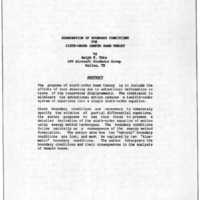Examination of Boundary Conditions for Sixth-order Damped Beam Theory
Item
-
Title
-
Examination of Boundary Conditions for Sixth-order Damped Beam Theory
-
Report Number
-
WL-TR-91-3078 Volume I, p. BBA-1 thru BBA-15
-
Creator
-
Tate, Ralph E.
-
Corporate Author
-
LTV Aircraft Products Group
-
Laboratory
-
Wright Laboratory
-
Date
-
1991
-
Date Issued
-
1991-08
-
Extent
-
15
-
Contract
-
Laboratory Research - No Contract
-
DoD Project
-
2401
-
DoD Task
-
240104
-
Identifier
-
ADA241311
-
Format
-
1 online resource
-
Abstract
-
The purpose of sixth-order beam theory is to include the effects of core shearing due to extentional deformation in terms of the transverse displacements. The constraint to eliminate the extentional motion reduces a twelfth-order
system of equations into a single sixth-order equation. Since boundary conditions are necessary to completely specify the solution of partial differential equations, the author purposes to use this forum to present a detailed derivation of the sixth-order equation of motion using energy method techniques. The boundary conditions follow naturally as a consequence of the energy method formulation. The author show how two "natural" boundary conditions are lost, and must be replaced by two "kinematic" boundary conditions. The author interprets the boundary conditions and their consequences in the analysis of damped beams.
-
Description
-
The purpose of sixth-order beam theory is to include the effects of core shearing due to extentional deformation in terms of the transverse displacements. The constraint to eliminate the extentional motion reduces a twelfth-order
system of equations into a single sixth-order equation. Since boundary conditions are necessary to completely specify the solution of partial differential equations, the author purposes to use this forum to present a detailed derivation of the sixth-order equation of motion using energy method techniques. The boundary conditions follow naturally as a consequence of the energy method formulation. The author show how two "natural" boundary conditions are lost, and must be replaced by two "kinematic" boundary conditions. The author interprets the boundary conditions and their consequences in the analysis of damped beams.
-
Distribution Classification
-
1
-
Distribution Conflict
-
No
-
DTIC Record Exists
-
No
-
Illinois Tech Related
-
No
-
Photo Quality
-
Not Needed
-
Report Availability
-
Full text available
-
Type
-
article
 article06
article06